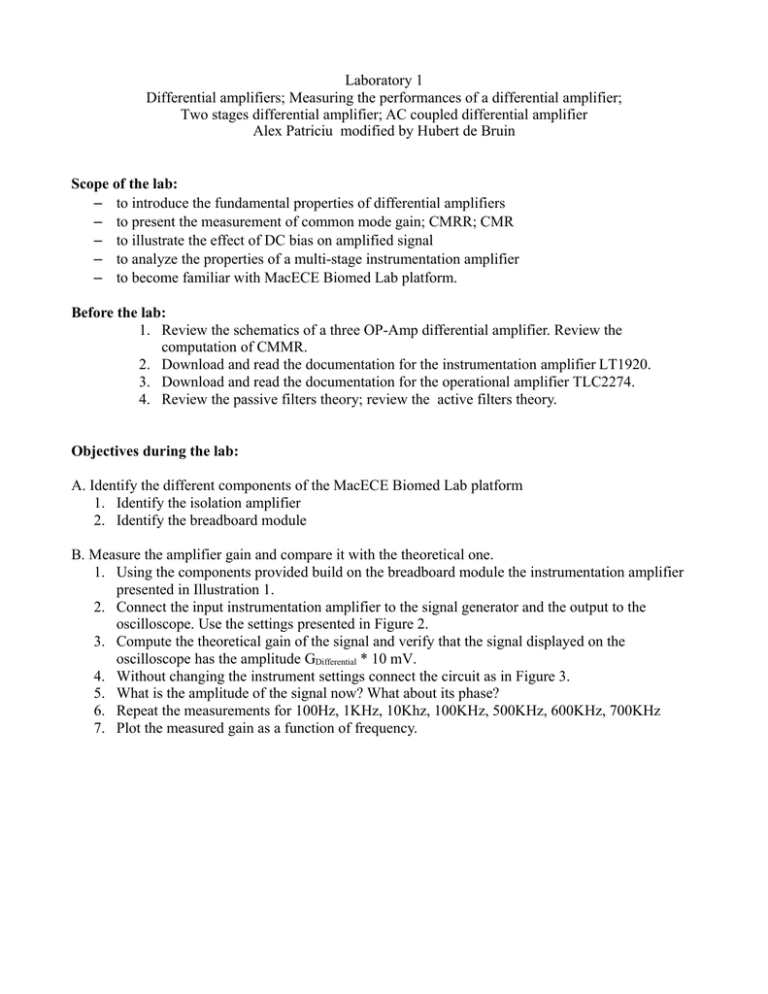Lab 1
advertisement

Laboratory 1 Differential amplifiers; Measuring the performances of a differential amplifier; Two stages differential amplifier; AC coupled differential amplifier Alex Patriciu modified by Hubert de Bruin Scope of the lab: – to introduce the fundamental properties of differential amplifiers – to present the measurement of common mode gain; CMRR; CMR – to illustrate the effect of DC bias on amplified signal – to analyze the properties of a multi-stage instrumentation amplifier – to become familiar with MacECE Biomed Lab platform. Before the lab: 1. Review the schematics of a three OP-Amp differential amplifier. Review the computation of CMMR. 2. Download and read the documentation for the instrumentation amplifier LT1920. 3. Download and read the documentation for the operational amplifier TLC2274. 4. Review the passive filters theory; review the active filters theory. Objectives during the lab: A. Identify the different components of the MacECE Biomed Lab platform 1. Identify the isolation amplifier 2. Identify the breadboard module B. Measure the amplifier gain and compare it with the theoretical one. 1. Using the components provided build on the breadboard module the instrumentation amplifier presented in Illustration 1. 2. Connect the input instrumentation amplifier to the signal generator and the output to the oscilloscope. Use the settings presented in Figure 2. 3. Compute the theoretical gain of the signal and verify that the signal displayed on the oscilloscope has the amplitude GDifferential * 10 mV. 4. Without changing the instrument settings connect the circuit as in Figure 3. 5. What is the amplitude of the signal now? What about its phase? 6. Repeat the measurements for 100Hz, 1KHz, 10Khz, 100KHz, 500KHz, 600KHz, 700KHz 7. Plot the measured gain as a function of frequency. A B C D E F G H BT? 1 1 7 8 3V 2 U? VIn+ 2 2 + 6 VOut BT? 3V 2 5.49K LT1920 R? 4 1 5 1 VIn- 3 3 4 5 6 4BD4 Biomedical Instrumentation Course Title: Lab1 Project: Differential Amplifier File: InstAmp1 Number: 1 Date: 2009 Page: 1/1 Rev. : 1.0 Illustration 1: Basic differential amplifier with a gain of 10 Illustration 2: Schematic for measuring the noninverting gain C. Measure the CMRR 1. Connect the equipment as shown in Figure 4. 2. Set the input as shown in Figure 4. (100Hz, 3Vpp). This will be you common mode voltage. 3. Measure the common mode output voltage. 4. Calculate the common mode gain GCM = Vout CM / Vin CM. 5. Calculate the common mode rejection ratio CMRR = GDifferential / GCM and CMR(dB) = 20log10(CMRR) 6. Repeat the measurements for 100Hz, 1KHz, 10Khz, 100KHz, 500KHz, 600KHz, 700KHz 7. Plot the measured CMMR as a function of frequency Illustration 3: Schematic for measuring the inverting gain Illustration 4: Schematic for measuring the common mode gain D. Add the second amplification stage 1. Add a second amplification stage with a gain of 11 to the differential amplifier as shown in Illustration 5. Use ¼ of the TLC2274. 2. Generate a sinusoidal signal with 10mV p-p amplitude and 100Hz frequency. Use the schematic from Illustration 2 and measure the achieved gain. 3. Repeat the measurements for 100Hz, 1KHz, 10Khz, 100KHz, 500KHz, 600KHz, 700KHz. 4. Plot the gain versus frequency. A B C D E F G H BT? 1 1 U?A VIn+ 2 3 2 + 6 3 - 2 + 1 VOut 11 BT? 3V 2 5.49K LT1920 R? 4 1 5 1 VIn- 4 7 8 3V 2 U? 1K R? 1/4_TLC2274 R? 10K 3 4 5 6 4BD4 Biomedical Instrumentation Course Title: Lab1 Project: Differential Amplifier File: InstAmp1 Number: 1 Date: 2009 Page: 1/1 Rev. : 1.0 Illustration 5: Differential amplifier with two stages; G = 110 E. Study the effect of added DC input component on the output. 1. Set the signal generator to add an offset of 20mV to the sinusoidal signal. 2. What does the output signal look like? 3. Explain what is going on? 4. DC offsets may be present in biomedical signals. What can you do to remove them? F. Biomedical Amplifier with HP and LP filters 1. Insert a passive HP and an active LP filter in the biomedical amplifier as shown in Illustration 6. Compute the component values such that you achieve a band-pass filter with cutoff-frequencies of 1.5Hz and 400Hz . 2. Generate a sinusoidal signal with 10mV p-p amplitude and 100Hz frequency and 20mV DC offset. Connect the biomedical amplifier to the signal generator and to the oscilloscope. 3. What does your output look like? 4. Verify that the high-pass filter effectively removes the DC component from the input signal. A B C D E F G H BT? 1 1 U?A VIn+ 2 3 2 C? + 6 1 - 2 3 CHPF 2 + 1 VOut 11 BT? 1K 1/4_TLC2274 R? RHPF R? 3V 2 5.49K LT1920 R? 4 1 5 1 VIn- 4 7 8 3V 2 U? R? 10K 3 C? 1 2 CLPF 4 5 6 4BD4 Biomedical Instrumentation Course Title: Lab1 Project: Differential Amplifier File: InstAmp1 Number: 1 Date: 2009 Page: 1/1 Rev. : 1.0 Illustration 6: Biomedical amplifier with two stages and band pass filter G. Identify the headstage module and the HP module. Build the system from illustration 6 using the modules provided (ignore for now CLPF). Connect the system to the NI Labview board. Display the waveform on the screen. After the laboratory 1. Prepare a report with the plots required by questions B.7, C.7, and D.4 and answer to question E.3.
